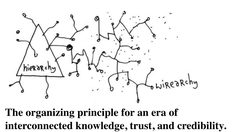Relevant Overviews
Overview: Digital Transformation
Digital transformation is an over-used, over-abused term. Here’s what it means to me.
From many strategies ...
In most organisations, the following strategies are barely on speaking turns, let alone fully integrated and mutually supportive:
- Internal communication: Every day, valuable ideas and information pour into your organisation as staff engage with stakeholders and discover useful knowledge online. But what happens then? If a piece of knowledge is valuable to them, it's probably also useful to their colleagues ... so why does so little of it circulate within your organisation?
- Internal collaboration: Are your staff still emailing documents to each other, and spending hours tracing the latest version and integrating changes?
- Knowledge management: Can your staff find the knowledge they need efficiently, share information effortlessly without flooding everyone’s Inboxes, and serendipitously discover relevant information around the digital equivalent of the office watercooler?
- External communication: There is no better advocate for any organsation than empowered staff and engaged audiences. Have you transformed your workforce into Social Ambassadors, and launched communities to engage your customers and stakeholders in co-defining the future?
- Training and employee engagement: Even if you have the tools, can your staff use them? Do they know why they should?
... to one strategy: build an internal innovation community
How can you integrate the above strategies, processes and tools? By treating them as different aspects of one, overarching goal: the creation of an internal innovation community throughout your organisation.
everyone is trained and motivated to share knowledge internally and externally, supported by efficient tools and processes
The idea is to frame the above strategies, processes and tools as interconnected tactics within an overall strategic framework. This aligns them to a shared set of goals: an organisation where everyone is trained and motivated to share knowledge internally and externally, supported by efficient tools and processes for knowledge management, internal and external communications.
From Strategy to Implementation
Having such a strategy is all very well, but noone will notice if you never implement it. You'll need to plan for unknowns, coordinate experts who have never worked together before, and integrate project and change management so that:
- change rolls out with the new features, tools and processes,
- these are developed with your staff, not foisted upon them.
I’ve specialised in the intersection of internal and external communications, collaboration and knowledge management since 1995. If you need help, get in touch.
More services: start with Communication strategy.
Relevant resources

despite all the talk about culture, many business leaders remain confused... organizational culture is “the shared basic assumptions, values, and beliefs... taught to newcomers as the proper way to think and feel...think of culture as a management system... makes the idea much more concrete...staff... make all sorts of decisions every day ... in a…

"the basics of human resources management goals and practices have remained little changed, philosophically and practically.... The main metaphor today’s HR professionals live in is still a machine with its designed-and-fitted parts and cogs, as opposed to the ‘living’ system of social networks in which people participate and interact... Let’s …

"So, does engagement actually cause higher performance, or are high-performing employees just more engaged?... In one of the few robust studies to examine this issue, Ben Schneider and colleagues mined archival engagement and performance data for several Fortune 100 companies. " - To Motivate Employees, Help Them Do Their Jobs Better
"Employees don't want to be "satisfied" as much as they want to be engaged. What they want most is a great boss who cares about their development, and a company that focuses on and develops their strengths." - Employee Satisfaction Doesn't Matter | LinkedIn

"Internal communications are responsible for engagement, which can enable employees to actively play a part in shaping the values and the type of experience customers have. Engaged employees who have been inspired and experience the vision, values and mission will then be strong advocates as they work and become involved in the brand themselves…